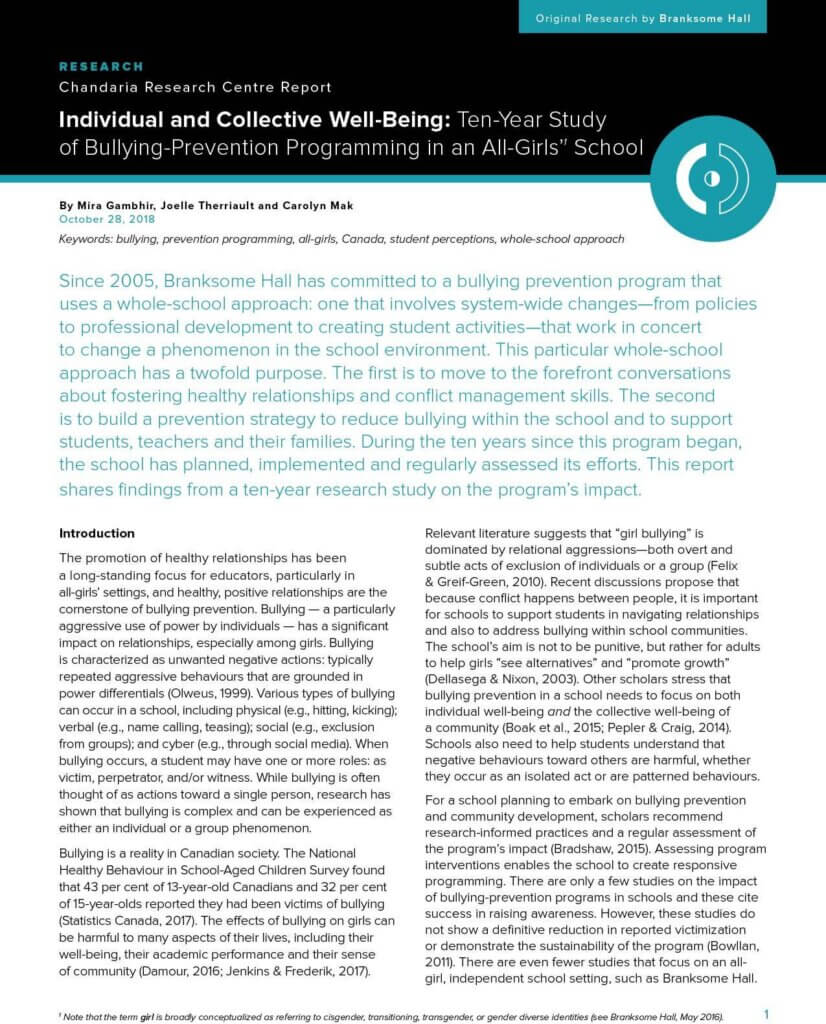Branksome Hall
Branksome Hall’s Whole School Approach to Bullying Prevention
Published On:
Written By: Mira Gambhir, Joelle Therriault and Carolyn Mak

The Road After: A Longitudinal Study of the Lives and Early Careers of Alums
Overview
Since 2005, Branksome Hall has committed to a bullying prevention program that uses a whole-school approach: one that involves system-wide changes—from policies to professional development to creating student activities—that work in concert to change a phenomenon in the school environment. This particular whole-school approach has a twofold purpose. The first is to move to the forefront conversations about fostering healthy relationships and conflict management skills. The second is to build a prevention strategy to reduce bullying within the school and to support students, teachers and their families. During the ten years since this program began, the school has planned, implemented and regularly assessed its efforts. This report shares findings from a ten-year research study on the program’s impact.
Introduction
The promotion of healthy relationships has been a long-standing focus for educators, particularly in all-girls’ settings, and healthy, positive relationships are the cornerstone of bullying prevention. Bullying — a particularly aggressive use of power by individuals — has a significant impact on relationships, especially among girls. Bullying is characterized as unwanted negative actions: typically repeated aggressive behaviours that are grounded in power differentials (Olweus, 1999). Various types of bullying can occur in a school, including physical (e.g., hitting, kicking); verbal (e.g., name calling, teasing); social (e.g., exclusion from groups); and cyber (e.g., through social media). When bullying occurs, a student may have one or more roles: as victim, perpetrator, and/or witness. While bullying is often thought of as actions toward a single person, research has shown that bullying is complex and can be experienced as either an individual or a group phenomenon.
Bullying is a reality in Canadian society. The National Healthy Behaviour in School-Aged Children Survey found that 43 per cent of 13-year-old Canadians and 32 per cent of 15-year-olds reported they had been victims of bullying (Statistics Canada, 2017). The effects of bullying on girls can be harmful to many aspects of their lives, including their well-being, their academic performance and their sense of community (Damour, 2016; Jenkins & Frederik, 2017).
Relevant literature suggests that “girl bullying” is dominated by relational aggressions—both overt and subtle acts of exclusion of individuals or a group (Felix & Greif-Green, 2010). Recent discussions propose that because conflict happens between people, it is important for schools to support students in navigating relationships and also to address bullying within school communities. The school’s aim is not to be punitive, but rather for adults to help girls “see alternatives” and “promote growth” (Dellasega & Nixon, 2003). Other scholars stress that bullying prevention in a school needs to focus on both individual well-being and the collective well-being of a community (Boak et al., 2015; Pepler & Craig, 2014). Schools also need to help students understand that negative behaviours toward others are harmful, whether they occur as an isolated act or are patterned behaviours.
For a school planning to embark on bullying prevention and community development, scholars recommend research-informed practices and a regular assessment of the program’s impact (Bradshaw, 2015). Assessing program interventions enables the school to create responsive programming. There are only a few studies on the impact of bullying-prevention programs in schools and these cite success in raising awareness. However, these studies do not show a definitive reduction in reported victimization or demonstrate the sustainability of the program (Bowllan, 2011). There are even fewer studies that focus on an allgirl, independent school setting, such as Branksome Hall.







